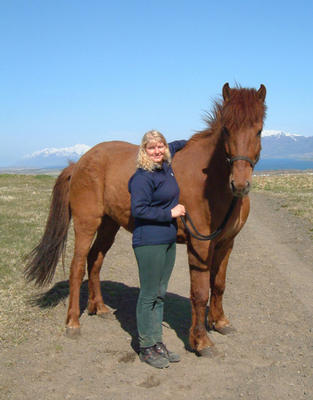Det finns en häst som legat på annons för ett par år sedan som sägs vara 160 cm.
Múfasa frá Saurbae. Bandmätt 160 men stångmätt 156 cm. Född på Island, exporterad till USA. Föräldrarna var 136 cm och 143 cm.
Jag personligen ser fler större islandshästar nu än för ~15 år sedan när jag började med rasen. Men som många redan skrivit är det fortfarande vanligast att se islandshästar i storleken 130-140.
Kikade lite på FEIFs hemsida. För att få 9.5-10 för proportioner på avelsbedömning är kriterierna:
- The horse should display splendour and presence.
The legs should be long and the body light and cylindrical in shape with front, middle and hind sections equal. The highest point at the withers should always be higher than the highest point of the croup.
Får hästen lägsta poäng, dvs. 6.5 kan det vara för att:
- The horse is very low at the withers.
- The horse is heavy-set, with a deep chest, a heavy body (very round or flat-sided).
- The legs are short.
- The horse is short and blocky and/or very disproportionate in lenght, front, middle and hind sections.
- The horse is disproportionate in the front and the back sections (width, depth) including the chest being too narrow (collapsed).
I reglementet står det alltså att hästen ej bör vara väldigt låg i manken. Men det nämns inga siffror. Vad är då "very low at the withers"? Jag tycker det är tydligt att man inte syftar på att manken ska vara högre än korset, för det tas upp i en egen punkt, utan att man syftar på att det någonstans finns en gräns för vilken mankhöjd som bör premieras och vilken som inte bör premieras. Men denna gräns är enbart en lägre "osynlig" gräns - någon övre finns överhuvudtaget inte.
På föl- och unghästbedömningar skrivs detta om proportioner:
6. Proportions:
6.1. Trunk form: from flat ribbed to cylindrical describes the line of the ribcage from flat ribbed ( which implies often a narrow back and a narrow chest [1] and [2]) to cylindrical, which lets the line of back and the lower line of the abdomen appear parallel, when seen from the side.
Attention: Well fed foals (and ridden horses) appear more cylindrical. (Note the depth of the chest!)
6.2. Trunk impression: from heavy build to light build
describes the impression of the trunk in its intirety from heavy built [1] ( in combination with deep chest and/or drop form of the trunk cross-section) to elegant [5]
The ideal is an elegant horse, which has a broad enough back and broad enough chest with good muscling. Heavy build foals tend to have a deep chest, which results in a forward shifted centre of gravity.
Attention: A MOMENTARY higher/taller hind end of a foal, which happens during growth spurts, has nothing to do with a heavy front end!
6.3. Leg length: from short to long
describes the length of the legs, from the elbow to the sole.
The legs should be as long as possible [5].
Attention: Does a foal look like an adult horse, because its depth of the trunk is proportionate in relation to the length of its legs, it will have short legs later on. Reason: The length of a foals legs is 95% - 98% complete in its development at birth. The depth of the
trunk can grow more than twice its size from birth to adulthood.




